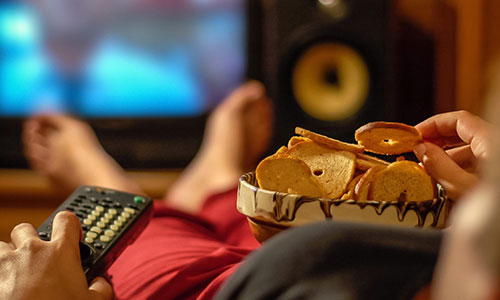How to break 4 bad eating habits
1. Huge portions
In some circumstances, we judge how full we are and how much we eat on external cues, such as how much food is left on our plate or the size of the packet we’re eating from, rather than internal physiological cues like hunger.
Portion sizes are bigger than ever before. Think about a 175ml glass of wine for example. You’ll tell yourself: “I’ve had one drink” when in reality you’ve consumed 2.3 units of alcohol; this is known as ‘portion distortion’. One 114g block of chocolate can be up to nine portions, but few people will share it among nine people or eat it over nine days.
How to beat it
Serve yourself from smaller plates and cups at home and read the labels of store-bought food to understand how many servings are included in the pack you’ve purchased. Be aware that a packet of six biscuits may suggest four biscuits per serving. Eat by serving size rather than the size of the packet.
Read our guide to portion sizes.
2. Matching the crowd

Do you usually manage to avoid dessert at a restaurant? What if everybody else at your table did, would you order one then? The same happens when we drink at a bar. Subconsciously, we seek social approval by matching our behaviour to the norms of a group or social situation and it can be challenging to resist this compulsion.
How to beat it
Plan ahead and decide how much you’re going to eat or drink before you arrive. Be prepared to encounter resistance as others may encourage you to consume more. Enlist your friends and family to support you in your healthy eating goals.
3. Distracted eating

With increasingly busy lives, we tend to give less and less thought to what, when and how we’re eating. We eat on the run, at the desk, or in front of the TV, while sometimes we eat nothing at all and get so hungry that we overcompensate when we finally get the chance. Research shows we’re inclined to eat more when we’re distracted.
How to beat it
Be present and engaged in the act of eating. Take time out to consume meals rather than eating at your desk. This will help you to be more aware of how much you’re eating.
Read our guide to eating mindfully.
4. The halo effect
Words printed on packaging such as ‘low fat’, ‘low sugar’ and ‘healthy’ can make us believe that products are healthier and less calorific than they actually are. This can produce a halo effect where we then allow ourselves to consume more to compensate for the savings we believe we’ve made.
How to beat it
Scrutinise labels to check that a ‘low fat’ product isn’t loaded with sugar, or that a single portion doesn’t equate to multiple servings. Count the calories per serving and make sure you’re deducting the full amount you eat from your daily allowance. Try to train yourself to look at nutritional information labels so you can make informed decisions as you shop.
Last updated Tuesday 20 September 2022
First published on Friday 27 January 2017

